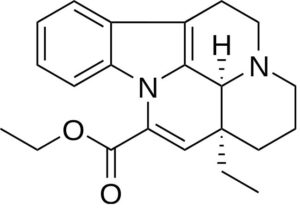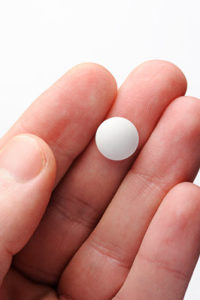Table of Contents
Vinpocetine (periwinkle extract, ethyl apovincaminate, Cavinton, Bravinton, Ceractin, Intelectol) is a semi-synthetic derivative of vincamine, an alkaloid derived from the lesser periwinkle plant (Vinca Minor L.).

Vinpocetine was first isolated from the periwinkle plant in 1975 by chemist Csaba Szántay. Hungarian pharmaceutical company Gedeon Richter began manufacturing Vinpocetine in 1978. Vinpocetine continues to be one of the company’s top selling drugs world-wide.[i]
Vinpocetine is used as a prescription drug in Japan, Europe, Mexico and Russia for the treatment of cognitive and cerebrovascular disorders. In the USA and Canada, Vinpocetine is sold as an OTC dietary supplement.
As a nootropic, Vinpocetine is used primarily to increase cerebral blood flow.
Other uses include using Vinpocetine for the prevention of motion sickness, menopause symptoms, chronic fatigue syndrome, seizure disorders, hearing and eye disorders, and even as a topical application to increase female sexual response.[ii]
Here we’ll investigate Vinpocetine’s value as a nootropic and to optimize cognition.
Vinpocetine helps:
- Cerebral Circulation. Vinpocetine helps boost blood flow to and within the brain. Improving the flow of oxygen and glucose that feed ATP to power brain cells. Improving alertness, cognition, concentration, memory and mood.
- Neuroprotectant. Vinpocetine blocks the accumulation of sodium in neurons, reduces the toxic effects of oxidative stress, inhibits the enzyme PDE1 and boosting blood flow, scavenges free radicals, and protects neurons from glutamate and NMDA toxicity.
- Neuroplasticity. Vinpocetine inhibits the enzyme PDE1 which can increase cAMP and cGMP. These cyclic nucleotides in turn activate a series of kinases that phosphorylate the transcription factors cAMP response element binding protein (CREB) and serum response factor (SRF), leading to the expression of plasticity-related genes.[iii] Boosting neuroplasticity enhances cognition and memory.
Overview
Vinpocetine (Cavinton, Intelectol) is a unique nootropic supplement derived from the lesser periwinkle plant (Vinca Minor).
A flowering plant native to central and southern Europe and Turkey, Vinca Minor is also grown as ground cover in the United States.

Since it was first released in 1978, Vinpocetine has earned a well-deserved reputation with the nootropics community for optimizing cognitive health. Primarily by boosting cerebral blood flow.
But to understand how and why Vinpocetine boosts cognition and protects your brain, we need to dive in to how blood flows in your brain.
An optimized adult brain gets about 1/7th of your heart’s output of blood every minute. Your brain needs this blood flow for a constant supply of glucose, oxygen and other nutrients to keep it functioning properly.
Unlike other organs and muscles in your body, your brain cannot stand an interruption in this steady flow of blood.
Two carotid arteries in the sides of your neck send blood to the front and top of your brain. Arteries in your vertebrae (spine) join with your carotid arteries at the base of your brain to form the Circle of Willis.[iv]
The Circle of Willis is critical because it is the only area of your body where all four major blood vessels join. Allowing blood to be sent to areas where it is needed. Even if one of the major blood vessels becomes blocked.
We’ll take a look at “How things go bad” later in this article. The good news is that Vinpocetine can have a profound effect on maintaining and repairing your brain’s blood vessels, cerebral blood flowing through the Circle of Willis, and to individual brain cells.
Vinpocetine not only helps increase cerebral blood flow, it also works as a powerful antioxidant and anti-inflammatory in your brain.
How does Vinpocetine work in the Brain?
Vinpocetine boosts brain health and function in several ways. But two in particular stand out.
- Vinpocetine boosts cerebral circulation. Your brain only accounts for about 2% of your bodyweight, but it consumes about 20% of the oxygen and nutrients circulating in your blood.[v] This is why strong, healthy cerebral blood flow is so critical to your brain health and cognitive performance.
Vinpocetine inhibits an enzyme called PDE1 (phosphodiesterase type 1) while reducing calcium levels in brain cells. When both of these are elevated, the smooth muscle in blood vessels contract, narrowing the diameter of blood vessels. And restricting blood flow to that area of the brain.
You may be familiar with PDE5 inhibitors like Viagra® which work to dilate blood vessels and maintain healthy blood flow to your penis. Vinpocetine has a similar mechanism of action in your brain.
In two separate clinical studies, chronic ischemic post-stroke patients were treated with either a single infusion, or daily infusion of Vinpocetine for 2 weeks.
Vinpocetine increased cerebral glucose uptake and glucose metabolism in both the stroke region of the patient’s brains as well as the intact brain tissue.
Patients in the 2-week long treatment also showed increased cerebral blood flow especially in the thalamus, basal ganglia and visual cortex regions of the brain.[vi]
- Vinpocetine is an anti-inflammatory. Vinpocetine prevents the upregulation of NFκB (nuclear factor kappa-light-chain-enhancer of activated B cells) by TNFα (tumor necrosis factor alpha).
This sounds a little complicated, but has serious implications in the development of Parkinson’s and Alzheimer’s Disease. Here’s how it works…
NFκB is a protein complex that controls transcription of DNA, cytokine production (signaling protein) and cell survival. TNFα is a signaling protein (cytokine) involved in inflammation produced by neurons. Vinpocetine inhibits this action.
Vinpocetine also reduces the TNFα-induced expression of the mRNA of pro-inflammatory molecules such as interleukin-1β, monocyte chemoattractant protein-1 (MCP-1), and vascular cell adhesion molecule-1 (VCAM-1).
Researchers have found that Vinpocetine prevents this inflammatory response at the cellular nucleus level. And this mechanism of action is independent of Vinpocetine’s action on PDE1.
This is a very big deal because TNFα contributes to the neuronal cell death found in Parkinson’s Disease. And there is growing evidence that the accumulation of amyloid-β protein leads to an upregulation of interleukins and TNFα that contributes to neurodegeneration leading to Alzheimer’s Disease.
Scientists are now working on trying to determine if Vinpocetine can reduce inflammation in the brain. And help protect the brain from developing Parkinson’s or Alzheimer’s.[vii]
How things go bad
Poor cerebral blood flow, inflammation and free radicals (oxidation) can damage your brain. And one of the ways this manifests is memory loss. Left unchecked, it can develop into serious neurodegenerative diseases like Alzheimer’s and Parkinson’s Disease.
↓ Cognitive function declines
↓ Inflammation kills brain cells from the inside
↓ Free radicals destroy neurons and synapses
↑ Anxiety, depression and moodiness increase
↓ Concentration and memory declines
Poor cerebral circulation causes a domino effect in the brain affecting many critical processes. Memory, cognition, and decision-making all suffer as a result.
Vinpocetine benefits
Vinpocetine is one of the most researched nootropics on the planet. It was introduced to clinical practice in Hungary in 1978 for the treatment of cerebrovascular (brain blood flow) disorders and related symptoms.
Since then Vinpocetine has become a “reference compound” in pharmacological research of cognitive deficits caused by hypoxia (oxygen deficiency), ischemia (inadequate blood supply) and research into cyclic nucleotides (cAMP and cGMP).
Vinpocetine’s mechanism of action in the brain includes:
- Increasing brain blood circulation and oxygen utilization
- Increased tolerance for hypoxia and ischemia
- Anticonvulsant activity
- Inhibiting the PDE1 enzyme
- Increasing the pliability of red blood cells
- Inhibiting the aggregation of platelets (blood clots)[viii]
Hundreds of studies in animals and humans have shown Vinpocetine can repair and reverse the effects of damage caused by strokes. Vinpocetine can prevent the inflammation and damage by free radicals that can lead to neurodegenerative diseases like Parkinson’s and Alzheimer’s.
Vinpocetine can improve glucose and oxygen supply to critical brain cells through increased blood flow. Improving cognition, concentration, mental agility, anxiety, depression and memory.
How does Vinpocetine feel?
You should be able to feel the effects of Vinpocetine within an hour of taking it.
Neurohackers report that Vinpocetine reduces brain fog and mental fatigue. Most experience improved focus, memory and even an improved sense of well-being.
Vinpocetine’s effect on short-, working- and long-term memory can be profound. Remembering names, numbers and life events becomes easier.
At work or in school, Vinpocetine can assist in learning and helping your brain commit it to memory. You should feel a significant difference in your ability to focus at work.
And like any nootropic, Vinpocetine is not going to turn back the clock 30 or 40 years. But it will help to keep your brain functioning more smoothly.
Vinpocetine Clinical Research
Vinpocetine Improves Memory
12 healthy female volunteers were treated with 40 mg Vinpocetine 3-times per day, or a placebo, for 2 days in this randomized double-blind crossover study.
On day 3 of the study, and one hour following morning dosage of Vinpocetine, the women completed a battery of psychological tests. The study found that those who used Vinpocetine had a significant improvement in memory when compared to placebo.[ix]
Vinpocetine Repairs Long-Term Potentiation
If you have been having problems with long-term memory lately, this study is for you.
Researchers produced a “medial septal lesion” on rats in the lab. The medial nuclei are an area of the brain composed of medium-size neurons. These neurons receive signals from different areas of your brain including your hippocampus.
A lesion cuts off communication with an important memory-formation area of your brain. The effect of a lesion in this study was on hippocampus function and the long-term potentiation pathway.
The scientists found that damage in this area of the brain negatively affects long-term potentiation. The rats were then given either physostigmine, piracetam, Vinpocetine or Hydergine one hour after the lesion. And once-a-day for 6 days after the operation.
The study found that all of the drugs used in this study produced complete restoration of long-term potentiation. And shows that Vinpocetine is one of the most effective and least expensive ways to restore long-term potentiation and long-term memory formation.[x]
Vinpocetine Enhances Cognitive Performance
A placebo-controlled, randomized double-blind trial was conducted at the University of Surrey with 203 dementia patients using Vinpocetine. Patients received either 10 mg of Vinpocetine 3-times per day, 20 mg of Vinpocetine 3-times per day or a placebo 3-times per day for 16 weeks.
The patients were assessed on cognitive performance and measure of quality of life, including depression. Both Vinpocetine groups experienced a significantly improved cognitive performance score compared to placebo.
The study concluded that Vinpocetine was useful in the management of patients with symptoms of dementia. And there was no statistical difference in cognitive scores with 10 mg or 20 mg of Vinpocetine.[xi]
Vinpocetine Dosage
Vinpocetine has a reputation among neurohackers and in clinical trials for safety at recommended doses.
The recommended dosage for Vinpocetine is 10 mg taken 3-times per day with food. Vinpocetine seems to be more effective when taken with a meal or high quality fat like coconut or olive oil.
You can safely dose up to 60 mg of Vinpocetine per day total. But clinical trials and user experience nearly always report that higher doses provide no added benefit.
Vinpocetine Side Effects
Vinpocetine is well-tolerated and safe for use by most people. But if you’re particularly sensitive to supplements and drugs, try a starting dose of 5 mg of Vinpocetine and see how your body reacts.
If you’re dealing with low blood pressure you should avoid using Vinpocetine. This nootropic affects blood flow not only in your brain, but through your entire system. If you take Vinpocetine and feel light-headed or dizzy it could be a sign your blood pressure is low.
Vinpocetine affects clotting factors in your blood. And may decrease red blood cell platelet aggregation. So if you are using blood thinners or high doses of aspirin you should avoid Vinpocetine.
Stop taking Vinpocetine at least 2 weeks before surgery because of its effect on blood thinning and flow.
The US FDA issued a warning June 2019 stating that women who are pregnant or intend on becoming pregnant should not use Vinpocetine. Because a recent animal study shows that Vinpocetine decreased fetal weight and increased the chances of a miscarriage.
Where to buy Vinpocetine
Vinpocetine usually comes in 5, 10 or 20 mg tablets.
Many countries around the world require a prescription to purchase Vinpocetine. In the USA, the FDA recently added Vinpocetine to its “Dietary Supplement Ingredient Advisory List“.
The FDA says this list, “is intended to quickly alert the public when the FDA identifies ingredients that do not appear to be lawfully included in products marketed as dietary supplements.”
In this instance, Vinpocetine was put on FDA’s list at the request of a major pharmaceutical company who intend to make and market it as a prescription drug. Which means you can no longer buy Vinpocetine from vendors such as Amazon or Bulk Supplements.
I use and recommend: Life Extension – Vinpocetine
Nootropics Expert Recommendation
Vinpocetine 10 mg 3-times per day
 We recommend using Vinpocetine as a nootropic supplement.
We recommend using Vinpocetine as a nootropic supplement.
Your body does not make Vinpocetine on its own. So you must take it as a supplement.
Vinpocetine easily crosses the blood-brain barrier and is available within an hour of taking it. Vinpocetine works more effectively if taken with food.
Vinpocetine is especially helpful for those suffering from brain fog and memory loss. Vinpocetine helps increase cerebral blood flow bringing more oxygen and nutrients to brain cells.
Vinpocetine is helpful for those dealing with stroke recovery. This nootropic helps restore blood flow to damaged areas of the brain affected by stroke. And helps prevent damage caused by the increase in free radicals typically released during stroke recovery.
Vinpocetine is also helpful for those suffering from Alzheimer’s. It has been shown to boost blood flow to areas of the brain affected by amyloid-β protein aggregation. Vinpocetine helps tame inflammation associated with the disease. And studies are now underway to determine if Vinpocetine can prevent Alzheimer’s from taking hold in the first place.
You can safely take up to 60 mg of Vinpocetine daily if needed. One dose first thing in the morning. One dose early afternoon. And the last dose in the evening.
And for memory, Vinpocetine is great to stack with most of the racetams. Neurohackers report good success stacking Vinpocetine with Gotu Kola.
I use and recommend: Life Extension – Vinpocetine









Join The Discussion - 173 comments
Mike
April 11, 2021
David, thanks so much for the heads on vinpocetine. I’ve been taking just 10mg in the morning for over 3 months, and coupled with mind lab pro, the results have been great. I can feel the brain opening up, and I test myself with puzzles everyday. My question is how long can I take it and how to get it, or substitute when all the supplies run dry? Thanks again.
David Tomen
April 15, 2021
Mike, I’m not aware of any long-term studies on Vinpocetine. I’ve been using it 3-times per day for years and it is still one of my favorite nootropics.
But getting Vinpocetine is another thing since the FDA and Big Pharma got involved. You can still get Vinpocetine from Life Extension as far as I know.
And unfortunately, there is no direct “substitute” for Vinpocetine. The closest we can get for better blood flow to the brain is Pine Bark Extract. Not as good in my opinion. But if there is no other choice …
Bruce
March 24, 2021
Hi David,
Five days ago I started giving 30 mg. of vinpocetine twice a day to a 88 year old friend who suffers from some sort of dementia. Holy cow! It works! After trying all sorts of the coconut oils and other suggested supplements nothing was really working. He has also taken the prescription medication Namenda for two years.
Today he started speaking more clearly. He acts as though he was just coming out of a deep sleep, with some brain fog. I doubt he’ll ever again be 100% but even this much improvement is very gratifying to see.
Is there anything else I might try that would complement the vinpocetine? Thank you.
David Tomen
March 24, 2021
Bruce, Vinpocetine is one of my favorite supplements. One other thing you may want to try is Pine Bark Extract.
Mohammad
March 14, 2021
Hi David,
can sudden cutting of Vinpocetine cause any complications?
In my case I recently developed partial epilepsy and mood issues, The doctor prescribed Lamictal and to increase my dose weekly for a month I’m halfway through now, but in order to see how Lamictal alone is helping me, I suddenly stopped taking Vinpocetine, thinking to get back to it once Lamictal is fully functioning.
I can tell, Lamictal is making me feel better in general but, some days there is an increase in seizures and discomfort, and I wonder if the sudden cut of Vinpocetine has something to do with it.
– I also take Mindlab Pro, Performance Lab Energy, and ADAM stack by Now foods.
I would love to hear what do you think?
David Tomen
March 15, 2021
Mohammad, I’ve never heard of Vinpocetine causing that type of reaction. But I highly recommend checking for any contraindications between Lamictal and each of the ingredients in every supplement you are using. Chances are good there is something going between Lamictal and a supplement you are using.
Vicki Jansen
May 20, 2021
I’ve been researching Vinpocetine intensively and just recently found your website.
It has really helped our son with epilepsy. He’s on three anti-epileptic drugs which haven’t helped much with seizures. Now less seizures and lifted the brain fog.
Vinpocetine is anti-inflammatory and helps bring more oxygen to the brain that bring down his seizure threshold.
It may also help heal the brain from injury including strokes.
I’m hoping the FDA doesn’t end up making it into an expensive drug!
David Tomen
May 20, 2021
Vicki, thanks for your report on Vinpocetine. It is truly my wish as well that the FDA does not get their way with this nootropic supplement. It’s one of my favorites. And as you said extremely effective.
Aryeh
March 8, 2021
is there any danger in combining vinpocetine with pie bark extract?
David Tomen
March 8, 2021
Aryeh, there is no danger and I do it every day.
Aryeh
March 8, 2021
awesome. thanks so much for your help, your the best! this website has been such a great resource
David Tomen
March 9, 2021
Thanks Aryeh.
Wong
March 8, 2021
Hi David
You recommend vinpocetine from double woods, however I email them and their reply was it’s has been discontinued. I cannot find any vinpocetine with other “ingredients “
David Tomen
March 8, 2021
Wong, Double Wood had a supply of Vinpocetine but it looks like they have run out. The only other place to get Vinpocetine now is Life Extension as far as I know here: https://www.lifeextension.com/vitamins-supplements/item01327/vinpocetine.
Dirk Blanchat
October 9, 2020
Would you recommend combining ADHD medication (Adderall) with Vinpocetine for its circulatory and antioxidant effects?
David Tomen
October 11, 2020
Dirk, absolutely 100% yes.
Robert Long
September 13, 2020
Im worried if there are some with Veinous Obstruction maybe in the Jugular veins or other sinus areas in the brain…
How would this nootropic help? Or would the increase cerebral pressure be dangerous? Release a thrombus? Produce a bad headache because of the low pressure.
Pulsatile Tinnitus is a sign of some type of abnormality.
Many may not know they Have an obstruction (not getting an MRV to diagnose) – as its now well known Brain Fog and OtherS are symptoms of this. And like myself want to find a pill to help.
Question:
Say someone has a clott in their Superior Sagittal Sinus, or other. Can this Nootropic be an Anti-Coagulant? Or do the other attributes cause risk?
David Tomen
September 14, 2020
Robert, Vinpocetine works like an anticoagulant. The risk is if someone suffers from low blood pressure or is using blood thinners. Vinpocetine is a very potent way to increase cerebral blood flow. It certainly does not increase blood pressure. Quite the opposite in fact.
eamonn sych
July 5, 2020
I’ve noticed a few people have been saying that Vinpocetine depletes dopamine, serotonin and few other neurotransmitters long-term. Is that true? Is it a safe nootropic to take? What’s your opinion?
David Tomen
July 6, 2020
Eamonn, the few people who are saying that Vinpocetine “depletes” neurotransmitters either have no idea what they’re talking about. Or they’re lying.
Yes, it’s safe to use unless you have a problem with low blood pressure or are on blood thinners. I’ve been using it 3-times per day for nearly a decade and it works as described in this review. It’s one of my favorite nootropics.
Mike
December 28, 2021
Hello David,
First thank you for your site and information, very helpful!
I also found places indicating the Vinpocetine has some action with neurotransmitters. Here is a paper on the subject https://pubmed.ncbi.nlm.nih.gov/10591410/
Some of the info in that paper is over my head, but it appears that there is some modulation of neurotransmitters or inhibition it looks like?
Thanks
David Tomen
December 28, 2021
Mike, Vinpocetine is used known primarily for boosting cerebral blood flow. But there has been lot more research published recently on this amazing nootropic. Including as you pointed out that Vinpocetine may also act as a blocker for voltage-dependent Na+ (sodium) channels. Which means it acts as a neuroprotectant. https://www.ncbi.nlm.nih.gov/pmc/articles/PMC5766389/